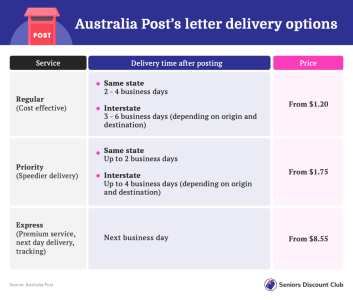Your mail service could be changing! What Australia Post's new proposal might mean for you
- Replies 22
Most people have become so digitally wired that traditional methods of communication, such as the postal service, are easily forgotten.
Knowing that our typed or text messages will arrive almost instantaneously is comforting. However, there is always a unique charm in receiving a physical letter through the mail.
Though, in recent times, fewer and fewer individuals are using the traditional postal system, especially for sending letters compared to articles and parcels.
This transition in mail usage has become more pronounced over time, resulting in Australia Post incurring significantly higher costs than the profits it gains from sending out mail.

At a glance, the issues Australia Post faces are simple; while its parcel business revenue has remained relatively steady, there's been an immense increase in the costs of delivering letters.
The latest audited figures (FY2022-2023) published by Australia Post indicated this cost, showing a loss of $200.3 million, with an additional loss of $384 (up 50 per cent from the year before) when it comes to delivering letters.
The report also stated that the average Australian household now only receives 2.2 addressed letters a week, which is a huge drop from the 8.5 letters per week we got back in 2008.
These losses were only the post office's second since it became a self-funded government business enterprise in 1989, with their previous annual audit seeing a $55.3 million profit.
It's for this reason that Australia Post CEO and Managing Director Paul Graham submitted a government consultation to modernise the postal service, which suggested some drastic changes ahead.
'The headwinds Australia Post is facing aren't new, and it's my job along with the leadership team to transform and modernise Australia Post so it can once again be a financially sustainable business,' Mr Graham said.
One of the post office's largest costs, according to the report, is delivering letters five days a week. As a result, there's an active push from Australia Post to reduce the frequency of letter deliveries with government permission.
Overall, the group's community service obligations cost them $442 million during their most recent audit period, up 27 per cent from the year before.
While we don't yet know the full details of what changes may be implemented, it's clear that Australia Post will have to make adjustments to remain financially viable.
'If we do everything in our power to run this business well and we get a favourable regulatory response towards modernisation, I'm confident that Australia Post will return to profit,' Mr Graham added.
This comes after Australia Post raised the basic postage rate from $1.10 to $1.20 on January 3, 2023, the first increase since 2020. However, this small change is not expected to fully compensate for the substantial losses.
The profitability of the business was impacted by several unexpected factors, including increased costs of wages, severe weather events, and labour shortages. Australia Post absorbed most of the additional costs.
Australia Post also reported a decrease in parcel and services revenue, with $3.80 billion earned during the first half of FY23, a 1.6 per cent drop from the previous year.
But despite this, it's still considered a strong result in a highly competitive market, especially when considering the boost in e-commerce activity seen during the COVID-19 lockdowns.

In a world where emails, texts, and instant messages are the norm, written letters are indeed becoming a rarity.
Members, do you remember when receiving one in the mail was a big deal? Does anyone in the community still send (or receive) letters regularly? How significant is this announcement for you? Share your thoughts in the comments below!
Knowing that our typed or text messages will arrive almost instantaneously is comforting. However, there is always a unique charm in receiving a physical letter through the mail.
Though, in recent times, fewer and fewer individuals are using the traditional postal system, especially for sending letters compared to articles and parcels.
This transition in mail usage has become more pronounced over time, resulting in Australia Post incurring significantly higher costs than the profits it gains from sending out mail.

Australia Post has lost considerable profits, with the blame largely resting on its letter delivery service. Credit: Shutterstock.
At a glance, the issues Australia Post faces are simple; while its parcel business revenue has remained relatively steady, there's been an immense increase in the costs of delivering letters.
The latest audited figures (FY2022-2023) published by Australia Post indicated this cost, showing a loss of $200.3 million, with an additional loss of $384 (up 50 per cent from the year before) when it comes to delivering letters.
The report also stated that the average Australian household now only receives 2.2 addressed letters a week, which is a huge drop from the 8.5 letters per week we got back in 2008.
These losses were only the post office's second since it became a self-funded government business enterprise in 1989, with their previous annual audit seeing a $55.3 million profit.
It's for this reason that Australia Post CEO and Managing Director Paul Graham submitted a government consultation to modernise the postal service, which suggested some drastic changes ahead.
'The headwinds Australia Post is facing aren't new, and it's my job along with the leadership team to transform and modernise Australia Post so it can once again be a financially sustainable business,' Mr Graham said.
One of the post office's largest costs, according to the report, is delivering letters five days a week. As a result, there's an active push from Australia Post to reduce the frequency of letter deliveries with government permission.
Overall, the group's community service obligations cost them $442 million during their most recent audit period, up 27 per cent from the year before.
While we don't yet know the full details of what changes may be implemented, it's clear that Australia Post will have to make adjustments to remain financially viable.
'If we do everything in our power to run this business well and we get a favourable regulatory response towards modernisation, I'm confident that Australia Post will return to profit,' Mr Graham added.
This comes after Australia Post raised the basic postage rate from $1.10 to $1.20 on January 3, 2023, the first increase since 2020. However, this small change is not expected to fully compensate for the substantial losses.
The profitability of the business was impacted by several unexpected factors, including increased costs of wages, severe weather events, and labour shortages. Australia Post absorbed most of the additional costs.
Australia Post also reported a decrease in parcel and services revenue, with $3.80 billion earned during the first half of FY23, a 1.6 per cent drop from the previous year.
But despite this, it's still considered a strong result in a highly competitive market, especially when considering the boost in e-commerce activity seen during the COVID-19 lockdowns.
Key Takeaways
- Australia Post has reported a loss of $200.3 million in 2022/23, only its second since it became a self-funded government enterprise in 1989.
- While the parcel business remains healthy, the group lost $384 million delivering letters in the same period.
- As traditional mail has decreased, Australia Post is advocating for a reduction in the frequency of letter deliveries and the modernisation of postal services.
- Chief Executive Paul Graham said losses are not new to businesses, and he will be looking to modernise Australia Post for the future.
In a world where emails, texts, and instant messages are the norm, written letters are indeed becoming a rarity.
Members, do you remember when receiving one in the mail was a big deal? Does anyone in the community still send (or receive) letters regularly? How significant is this announcement for you? Share your thoughts in the comments below!








